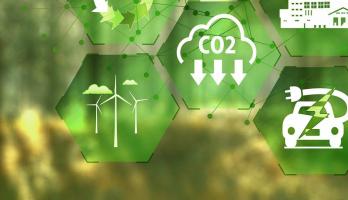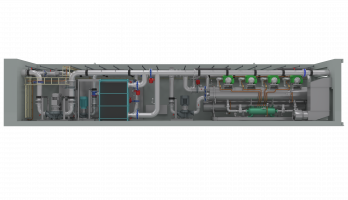
How refrigerants can withstand the future and increase machine efficiency
It has been clear since the new F-Gas Regulation that refrigerants make an important difference in cooling and heating applications. But how do operators identify the perfect refrigerant for their project? How can system efficiency be increased through the targeted use of refrigerants? And how important are safety and environmental friendliness? Daniel, Head of Sales & Business Development at ENGIE Refrigeration, explains.
Daniel, due to current climate policy events, there is a great deal of focus on increasing the efficiency of chillers and heat pumps and using the right refrigerant. But what properties characterise the perfect refrigerant?
Daniel: First of all, I would like to make it clear: There is no "one" perfect refrigerant. A closer look at ENGIE Refrigeration's broad product portfolio of chillers and heat pumps reveals, for example, high temperature differences from -21 to +110 degrees Celsius. In addition, there is a broad performance spectrum from 50 kilowatts to eight megawatts. It is obvious that one refrigerant alone cannot fulfil our customers‘ different requirements, which we meet with these diverse cooling and heating solutions. Nevertheless, there are three significant decision criteria for choosing the right refrigerant for the respective application: safety, environmental friendliness, efficiency and cost-effectiveness.
What is particularly important to ENGIE Refrigeration when using refrigerants?
Daniel: The central principle for the energy transition is "efficiency first". Because the cheapest energy is the energy that is not generated in the first place. We at ENGIE Refrigeration share this conviction with the Federal Ministry for Economic Affairs and Climate Action. In my opinion, this guiding principle should be focussed on much more in the current discussion about the F-Gas Regulation. For us at ENGIE Refrigeration, it is therefore all the more important to set a good example and continuously increase the efficiency of our chillers and heat pumps. Using the right refrigerant is of crucial importance here.
How do refrigerants actually help to increase the efficiency of machines? Which additional factors play a role?
Daniel: It depends on the thermophysical properties of the respective refrigerant. These include the vapour pressure curve, enthalpy of vaporisation, volumetric cooling capacity and the final compression temperature. The following questions must also be considered: What is the design of the compressor drive train? Is it an oil-free machine design? Which materials are used and what characterises them? This is followed by the targeted integration of the chiller or heat pump in order to increase overall efficiency. In particular, the seasonal overall efficiency levels must be taken into account: SEER (Seasonal Energy Efficiency Ratio), SEPR (Seasonal Energy Performance Ratio) and SCOP (Seasonal Coefficient of Performance). This can be deduced from the actual usage behaviour: Although the machine must be designed for 100 per cent load for extreme cold or hot periods; it runs at partial load for by far the largest part of the operating time. The key to greater system efficiency and thus to cost and CO2 savings therefore lies in the partial load.
Interesting. Can you give us a specific example of this?
Daniel: Of course. A direct comparison between a large turbo engine and our QUANTUM Power with high part-load efficiency makes this phenomenon very clear: Although the large turbo has a higher efficiency at 100 per cent load, it drops across the operating points due to its design, especially at a load below 50 per cent. Meanwhile, the EER (Energy Efficiency Ratio) value of the QUANTUM Power increases steadily in the partial load range. The result speaks volumes: our chiller gains six percent in efficiency over the entire year, saving 409 megawatt hours and 164 tonnes of CO2 compared to the large turbo. The most energy-efficient solution for increasing system efficiency must therefore be consideredholistically. Full load has only little informative value.
Holistic is a good keyword, because you also mentioned environmental friendliness as a decisive criterion for refrigerants. How can this be guaranteed in system operation?
Daniel: The main distinction here is between indirect and direct CO2 emissions. While indirect CO2 emissions are produced during electricity generation from various energy sources, direct CO2 emissions are released directly into the atmosphere from the refrigerant circuit. This happens, for example, in the event of refrigerant leaks. It is often underestimated that indirect emissions account for around 98 per cent of the system's life cycle assessment, meaning that the proportion of refrigerant leaks is minimal. In order to reduce CO2 emissions from heat pumps and chillers, it is therefore important to reduce indirect emissions, for example by using green electricity or by increasing the efficiency of the system.
And what role does the safety of refrigerants play in this context?
Daniel: Several properties determine the safe use of refrigerants in the respective chiller or heat pump: chemical and thermal stability, miscibility with oils and compatibility with various materials. Those responsible should also be familiar with the toxicity and flammability of refrigerants. In temperature-sensitive areas, such as airports, hospitals and data centres, all risk factors must be excluded. With the use of a wide range of A1, A2L and B2L refrigerants, we at ENGIE Refrigeration optimally fulfil the requirements of various application areas. Another tip: our optional PROTECT and PROTECT plus extensions. Their integrated system reliably monitors our QUANTUM and SPECTRUM series for refrigerant leaks and switches off potential ignition sources within PROTECT plus in a safety-oriented manner in an emergency. Meanwhile, other components in the machine room continue to run efficiently. PROTECT harmonises with A1 refrigerants, PROTECT plus is the safe option for A2L refrigerants.
What key recommendation on the subject of refrigerants would you like to give our readers at the end?
Daniel: The ideal "miracle refrigerant" for every application does not exist. As a decision-maker, you always have to find the right compromise between environmental impact, safety and cost-effectiveness for your specific requirements. In addition, the principle of "efficiency first" must always be taken into account. We at ENGIE Refrigeration will continue to represent this claim with our entire product portfolio in the future.
Daniel, thank you very much for the valuable insights!









